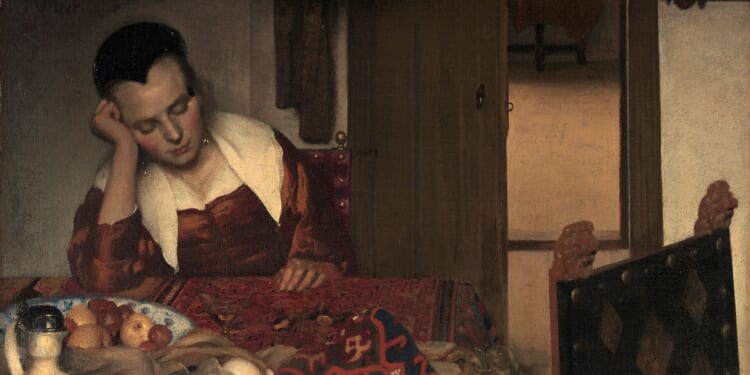Recent stories of note:
“Is a Vermeer self-portrait hiding behind his ‘sleeping maid’ at the Met?”
Martin Bailey, The Art Newspaper
Recent research by the Metropolitan Museum of Art’s conservators has uncovered further evidence of a hidden self-portrait of Johannes Vermeer in his painting The Sleeping Maid (1656–57), Martin Bailey reports. The likeness was originally reflected in a framed mirror in the background of the painting, a device found in other works of the Dutch Golden Age. It is a shame that the self-portrait was later overpainted by Vermeer, as there are no known surviving portraits of the artist. Nevertheless, the discovery does change our understanding of the painting, as it is now clear that the current title is a misnomer: far from a mere servant, the subject is a richly adorned model, who’s being painted by the artist. The research also provides further evidence of Vermeer’s technique: while many of his paintings may appear at first glance to be spontaneous genre scenes, every aspect of his works was carefully planned and reworked, sometimes over a period of several years.
“A lack of national identity has killed off the Great American Novel”
Michael P. Gibson, The Spectator World
The question of American literary degeneration has not infrequently been discussed in these pages. For his part, Michael P. Gibson argues that the public’s lack of interest in literature and the declining quality of the written word stem from “the erosion of a unified national identity and the country’s consequent trajectory toward a more fragmented society of different competing cultural tribes.” Fair enough, but one might reasonably object that some of the greatest American novels to date, including Hawthorne’s The Scarlet Letter (1850) and Melville’s Moby-Dick (1851), were written in the antebellum period, not exactly an era known for its national unity. Gibson is more on target when he outlines an opposition in the literary world between “hierarchies of prestige,” which he compares to Agamemnon, and “hierarchies of greatness,” akin to Achilles. The former is represented by the culturally dominant liberal institutions, such as the legacy media and the universities, which reward only identity-driven conformism and careerism in literature and therefore produce little of substance. The latter is embodied by a rising but culturally invisible tide of authors and readers who aspire to truth and beauty. Whether Achilles can triumph over Agamemnon remains to be seen.
“A mentor’s Odyssey”
A. E. Stallings, The Times Literary Supplement
For the last three centuries, not a decade has passed without at least one translation of the Odyssey into English. For the 2020s, it seems that the translation of record will be Daniel Mendelsohn’s (2025), reviewed by A. E. Stallings. It is a credit to Mendelsohn that he corrects many of the flaws of the last major translation, that of Emily Wilson (2017). Wilson had, for instance, rendered Kuklṓpōn huperphiálōn athemístōn (9.107), literally meaning “the arrogant, lawless Cyclopes,” as “high-minded mavericks,” in order to avoid “othering” these monstrous creatures. No such wokery in Mendelsohn, who translates “kynôpis,” an epithet of Helen literally meaning “dog-eyed,” as “bitch”; Wilson had translated the same epithet with the wordy and more neutral phrase “my face that hounded them.” There’s much else to praise in Mendelsohn’s Odyssey, from his sticking to the hexameter, to his imitating successfully the Greek word order, to his capturing of quite a few of Homer’s puns. Readers can get a taste of Mendelsohn’s translation in the April 2025 issue of The New Criterion.















